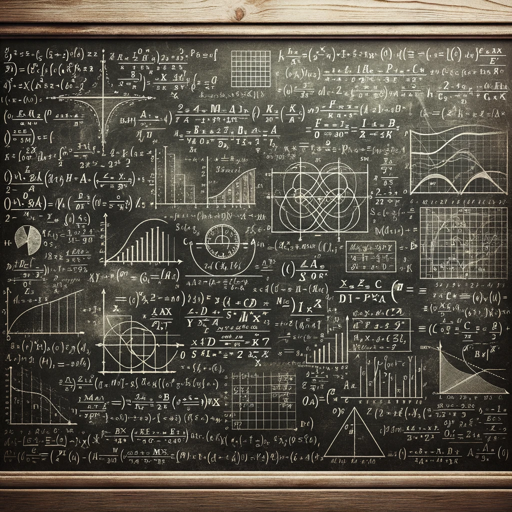math-AI Math Solutions
AI-powered Mathematical Problem Solver
Prove that (2n+7) < (n+3)^2 for all n in N
Solve: lim x -> inf (x^2 / e^x)
Min no. of pulled socks to guarantee a pair of the same colour
Determine f_avg for f(x) = 8x - 3 + 5e^(2-x) on [0,2]
Related Tools
Load More
math
The worlds most powerful math tool.

math
The worlds most powerful math tool. Solve math problems in different languages with step-by-step solution.

Math and Statistics Pro
Expert in solving high-level math and statistics problems.

Advanced Math and Matrix Expert
Deep expertise in matrix diagonalization and applications.

Advanced Math and Finance Solver
Expert in solving math and financial engineering problems.

Math & Physics 👉🏼 Algebra Calculus Stats
The most sophisticated, intelligent, complete and efficient Math + Physics tool ever created with AI. Expert in Algebra, Geometry, Calculus, Arithmetic, Trigonometry, Equations, Functions, Matrix, Probability, Statistics, and more. Integrated Calculator a
20.0 / 5 (200 votes)
Introduction to Mathematics
Mathematics is a field of study that explores quantities, structures, space, and change through various abstract and practical methods. It encompasses various branches such as arithmetic, algebra, geometry, calculus, and statistics. Mathematics is designed to provide a systematic approach to solving problems, making predictions, and understanding patterns and relationships. For example, in engineering, mathematics is used to design structures by calculating forces and stresses. In economics, it helps in modeling market behaviors and optimizing resources.

Main Functions of Mathematics
Arithmetic Operations
Example
Addition, subtraction, multiplication, and division.
Scenario
Calculating the total cost of groceries by adding the prices of individual items.
Algebraic Manipulation
Example
Solving equations and inequalities.
Scenario
Determining the break-even point in a business where revenue equals costs.
Statistical Analysis
Example
Analyzing data sets to find mean, median, and standard deviation.
Scenario
Assessing the performance of students in a school by analyzing their test scores.
Ideal Users of Mathematics
Students
Students benefit from mathematics as it helps them develop critical thinking and problem-solving skills, which are essential for academic success and everyday life.
Professionals
Professionals in fields such as engineering, finance, data science, and technology use mathematics to model complex systems, optimize processes, and make data-driven decisions.

How to Use Math
1
Visit aichatonline.org for a free trial without login, also no need for ChatGPT Plus.
2
Familiarize yourself with the key functionalities: mathematical problem solving, concept explanations, step-by-step solutions, and illustrative examples.
3
Identify the type of mathematical query you have, such as algebra, calculus, statistics, etc., and formulate your question clearly.
4
Use specific keywords related to your mathematical problem to get more precise answers and explore alternative methods for solving the problem.
5
Review the provided solutions and explanations thoroughly, ensuring you understand each step and concept. Ask follow-up questions if necessary.
Try other advanced and practical GPTs
Tech News Translator
AI-powered translation and news summaries.

スタートアップや新規事業のためのリーンキャンバス
AI-powered Lean Canvas for startups

Pieter Levels: Startup Adventures
AI-powered startup adventure game
FoundersGPT
AI-powered insights from entrepreneurial stories

Football Analyst
AI-powered NFL analysis and predictions.

GPT Search Master
AI-powered search for deep insights

論文・レポート添削!
AI-powered academic paper review tool

Video Editor Copilot
AI-powered editing for educational videos

CaloriesChecker.com
AI-powered nutritional analysis tool.

Anki Card Creator
AI-Powered Flashcard Generation Tool
公众号标题党大师
AI-Powered Headlines for Maximum Engagement

Integral Calculator
AI-Powered Integral Calculator for All

- Problem Solving
- Concept Explanation
- Step-by-Step
- Illustrative Examples
- Alternative Methods
Math Q&A
How do you solve complex integrals?
To solve complex integrals, I break down the integral into simpler parts, apply integration techniques such as substitution or integration by parts, and provide a detailed step-by-step solution, ensuring each step is clear and comprehensible.
Can you help with statistical analysis?
Yes, I can assist with statistical analysis by explaining concepts like probability distributions, hypothesis testing, regression analysis, and more. I provide detailed solutions and explanations to help you understand and perform statistical calculations.
What if I don't understand a step in your solution?
If you don't understand a step, you can ask for clarification, and I will provide a more detailed explanation or an alternative approach to the problem, ensuring you grasp the concept fully.
Can you explain mathematical theories and concepts?
Absolutely, I can explain a wide range of mathematical theories and concepts, from basic arithmetic to advanced topics in calculus, linear algebra, and beyond. Each explanation is tailored to your level of understanding.
How do you verify the correctness of your solutions?
I verify the correctness of solutions by cross-checking the results with established mathematical principles, using multiple methods where applicable, and ensuring that each step logically follows from the previous one.